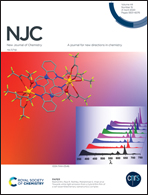Tunable acidity in mesoporous carbons for hydrolysis reactions†
Abstract
A mesoporous carbon (CMC) has been treated under acidic conditions (32.5 wt% HNO3 at 10 °C or 40 °C) to prepare two new carbon samples (HCMC10 and HCMC40), which developed higher acidity in terms of quantity of sites and surface acid strength. The properties of the three carbons have been studied by using various techniques (N2 adsorption/desorption, TEM, XRPD, Raman spectroscopy, 13C NMR, 2D 1H–13C NMR, and XPS). Aromatic –COOH and –OH groups were identified as the main surface acid sites. Acid site density has been determined by pulse liquid–solid phase adsorption experiments carried out in different liquids. The samples retained acidity features in water, due to hydrophobicity of the surfaces, while acidity dropped when measured in methanol. From NH3-TPD analysis, a ranking of acid strength could be obtained: HCMC40 > HCMC10 > CMC. The good acidity of the carbon samples allowed them to act as catalysts in the hydrolysis reaction of sucrose to glucose and fructose. The catalytic activity of the carbon samples was compared to that of Amberlite, a commercial sulfated acid resin; the observed kinetic constant of HCMC40 was similar to that of Amberlite.



 Please wait while we load your content...
Please wait while we load your content...